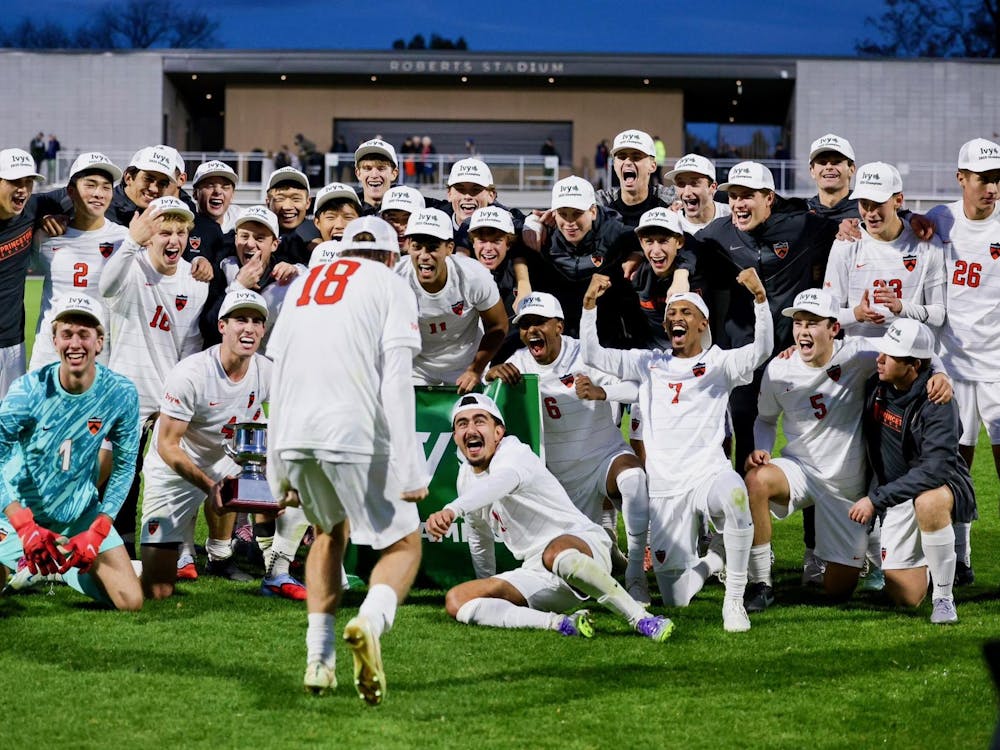However, fans of college hockey — specifically the Princeton men’s hockey team — need not worry about the opinions of committee members, for their sport’s process is remarkably transparent and objective. To pare down the 58 Division I men’s hockey teams to a field of 16 for the NCAA tournament, a simple mathematical system called PairWise Ranking is used.
“The part I like about it for sure is that there’s no arguing,” head coach Guy Gadowsky said.
“There’s no committee that might like one program because of past history. It’s how you perform that season. It’s fair for everybody.”
While the exact details are not made public, the version of PairWise Ranking used by the website uscho.com has successfully predicted the tournament field for 12 straight years, so it seems safe to say that the USCHO ranking has the NCAA’s system pretty well nailed down.
At the heart of the PairWise system is the familiar Ratings Percentage Index (RPI), which consists of three components: 25 is a team’s winning percentage, 21 percent is a team’s opponents’ winning percentage, and the remaining 54 percent is a team’s opponents’ opponents’ winning percentage.
The NCAA adjusts this value for RPI by discounting wins against weak opponents that would actually hurt a team in the rankings. A small bonus is given for victories over teams that finish in the top 15 of the RPI.
This means the Tigers’ twin killings of RPI No. 55 Brown won’t hurt their postseason chances, but their wins over RPI No. 4 Northeastern, No. 9 Yale, No. 10 Cornell and No. 14 St. Lawrence will all help.
The NCAA starts the PairWise process by designating the top 25 teams in the RPI as “teams under consideration” (TUCs). Each team is then compared with the other 24 teams based on four criteria: RPI, record against TUCs, record against common opponents and head-to-head matches.
For the first three criteria, one point is given to the team that posts a better value, with ties giving a point to both teams. In the head-to-head category, a team receives a point for each head-to-head victory, so a season sweep of a TUC virtually guarantees that a team will win that comparison.
Once all 600 comparisons are made, the teams are ranked based on the number of comparisons won. All 10 at-large bids are given out based on PairWise rank, and the brackets are seeded using the PairWise rankings after geography and intra-conference matchups are factored in.
There are six automatic bids in the NCAA tournament, one for the winner of each conference tournament. Two of the conferences, the Atlantic Hockey Association and College Hockey America, do not get teams in the PairWise top 16, meaning that there will be at least two teams outside the top 16 in the national tournament. Assuming that the other four conferences are won by teams ranked 16th or better, which has happened in each of the last three seasons, the top 14 teams in the PairWise rankings are guaranteed a bid.
The Boston University Terriers (27-5-4 overall) lead the most recent PairWise rankings, winning the comparisons with all other TUCs. Princeton (20-9-0) is precariously ranked No. 12 with 13 comparison wins. Competition for the last several spots is fierce, as three teams — St. Lawrence, Ohio State and Colorado College — are all tied in the 14th with nine comparison wins each.

With so many teams hovering around the cutoff line, Princeton will have to play well this weekend to hold off the gathering vultures hungry for a bid. Fortunately for the Tigers, they control their own destiny and are free to focus entirely on their own game.
“The only thing that you can control is winning,” Gadowsky said. “So [the PairWise] is not something that we stress. We try to stress playing the best game that we can, not so much that this may have large implications on the PairWise.”
As the conference tournaments draw to a close, there are bound to be peculiar postseason scenarios that will make fans’ and coaches’ heads spin. One such situation occurred last year, as Notre Dame found itself heading into its final game against the Northern Michigan Wildcats needing a win. Or a loss.
A win would have improved Notre Dame’s RPI enough to vault it into the tournament. But the Irish lost the game. Or, more relevantly, Northern Michigan won, moving itself up into the top 25. Notre Dame still won the comparison with the Wildcats, however, while the Minnesota State team just ahead of them lost this comparison. So, by changing the composition of the teams under consideration, Notre Dame was chosen instead of Minnesota State for the final at-large bid.
The bizarre kicker to this scenario is that Notre Dame could have missed the tournament with a tie. Had the game reached overtime, it is possible the Fighting Irish would have been forced to send the puck into their net.
While college hockey enthusiasts are unlikely to get such an extraordinarily juicy scenario this year, there will certainly be plenty of drama surrounding the final few bids. Princeton appears poised to make its second consecutive NCAA tournament appearance, but it still has some work to do before it can punch its ticket. As anyone on the 2006 Holy Cross team —or the heavily favored Minnesota team it upset — can attest, once a team has a ticket, anything can happen.







